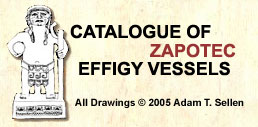| Key: NMAI 180086 |
| Actual Location: National Museum of the American Indian, Smithsonian Institution |
| Collection: Louis Gustave Bellon; George Heye (donated 1931) |
| Registration: Col. Bellon no. 301; NMAI cat. 180086.000 |
| Provenance: Zaachila, Center District, Oaxaca |
| Measurements: 45 x 41 cm. |
| Color: Grey clay |
| Chronology: Peche 500-600 AD |
| Click to view Chronology |
| Reference: Photograph of the piece in the Bellon collection in the archive of Marshall H. Saville, American Museum of Natural History, box 27. |
| Comments: In September 1894 Martínez Gracida found this piece in a grave next to three other identical objects. Soon after he sold the objects: One to Luis Reynaud, two to Lucio Smith, and one to Eduard Seler along with the rest of his collection. Today there are two identical artefacts in the Smithsonian Institution but they are not complete (see SMI 198426 and SMI 198427). These come from Lucio Smith via E. W. Nelson. There is a more complete object in the Peabody Museum (see PMAE 10609) that was gift from the AMNH in 1929. This was the urn donated by Seler in 1895. The fourth piece, the urn purchased by Luis Reynaud, ended up in the Bellon collection. George Heye bought the object at auction in Paris in 1928 or 1929. |
| Glyphs: The glyph C in the headdress. Based on the more complete objects, it also hade the glyph epsilon hanging from the ears. |
|
